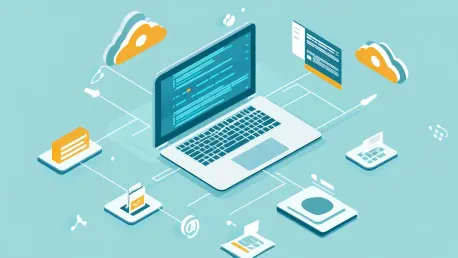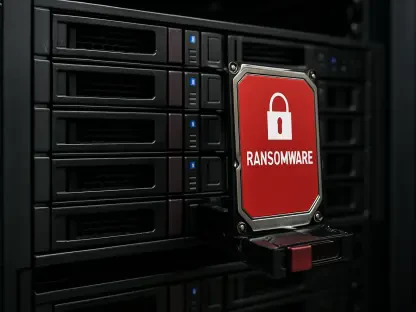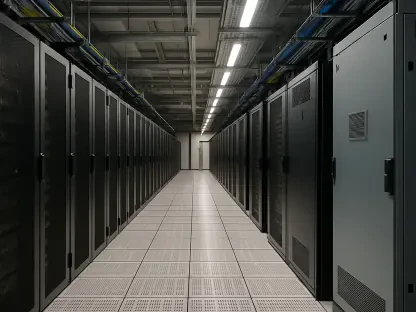Software-as-a-Service (SaaS) stands as a revolutionary model in the landscape of software delivery, drastically changing how applications are developed, deployed, and managed. From its humble beginnings to its current status as a fundamental component of cloud computing, SaaS has continually evolved, delivering unprecedented benefits while navigating complex challenges. This article endeavors to shed light on SaaS, its significance, and the future trends poised to further transform this dynamic field.
Defining SaaS
Historical Context and Evolution
Initially, software required manual installation on individual computers and servers, a time-consuming and technically demanding process. SaaS emerged as a game-changer by enabling instant, cloud-based software deployment, eliminating the need for local installations. Businesses were previously bogged down by the arduous tasks of managing IT infrastructure and ensuring software compatibility across diverse systems, but SaaS streamlined these processes significantly. This paradigm shift has opened new avenues for businesses, reducing reliance on in-house IT infrastructure and expertise.
Before the advent of SaaS, organizations faced substantial challenges in maintaining operational efficiency due to the complexity and cost of traditional software models. The merit of SaaS lies in its ability to standardize and simplify software delivery, allowing organizations to rapidly deploy applications with a global reach. Furthermore, SaaS’s pay-as-you-go model democratized access to advanced technologies, enabling even smaller enterprises to leverage powerful software tools that were once the exclusive domain of larger corporations. This democratization has fueled innovation across industries, making SaaS indispensable in the modern digital landscape.
Examples and Applications
SaaS manifests in numerous applications used daily. For consumers, services like Outlook for email, Google Docs for document management, and streaming platforms such as Netflix are quintessential SaaS solutions. These platforms epitomize the convenience and accessibility that SaaS offers, allowing users to enjoy seamless, ubiquitous access to software tools and entertainment services via the internet. The consumer market has wholeheartedly embraced SaaS, evident in the ubiquitous usage of these applications across various devices and environments.
In the financial sector, CRM systems like Salesforce, ERP solutions, and billing systems exemplify SaaS’s extensive reach, demonstrating its pivotal role in modern business environments. Financial institutions leverage SaaS for a myriad of functions, including client relationship management, financial reporting, and regulatory compliance. SaaS solutions in this domain provide the agility required to respond to market changes, while also ensuring the stringent security and compliance needed in the finance industry. Salesforce, for instance, has revolutionized the CRM landscape by providing customizable, scalable solutions that can be tailored to the unique needs of financial organizations, thereby enhancing operational efficiencies and customer satisfaction.
Operational Mechanics
Multi-Tenant Architecture
At the core of SaaS lies a multi-tenant architecture, wherein multiple users share a single infrastructure, but their data remains securely segregated. This design enhances efficiency, allowing providers to manage hardware, software, and security measures centrally. The multi-tenant approach is pivotal in scaling operations, as resources and maintenance efforts are shared across a broad user base, reducing costs and operational complexities for individual tenants. For end-users, this translates into seamless access to applications through a web browser, simplifying the user experience while ensuring resource optimization.
Multi-tenancy also allows service providers to handle peak loads more effectively by distributing resources among customers, thereby ensuring consistent performance. Security and data isolation are paramount in this architecture, with advanced encryption and access controls safeguarding user data. The advantages of this approach extend to continuous monitoring and optimization, where providers regularly assess system performance and security, applying updates and improvements universally. This ensures that SaaS users benefit from the latest technological advancements without the need for manual interventions or system disruptions.
IT Management Simplified
SaaS providers handle all aspects of IT management, from hardware maintenance to software updates. This ensures that users benefit from the latest features and security enhancements without investing in hardware or dedicating resources to software maintenance. IT specialization by the providers translates into a seamless experience for businesses, as they can focus on core activities without worrying about the technical underpinnings of their software solutions. The model epitomizes ease of access, particularly valuable in an era where remote work is increasingly prevalent.
The task of keeping systems up-to-date, which is critical for security and functionality, is managed centrally by SaaS providers. This central management mitigates the risk of discrepancies and incompatibilities that often plague traditional software deployment methods. Additionally, the ability to rapidly deploy updates and fixes across all users ensures a consistent experience, with immediate access to new features and enhancements. For businesses, this translates into significant time and cost savings, while also ensuring they remain at the cutting edge of technological advancements, critical for maintaining a competitive edge.
Benefits of SaaS
Cost-Effectiveness
One of the most significant advantages of SaaS is its cost-effectiveness. By eliminating the need for substantial upfront investments in data centers and IT resources, businesses can allocate their financial resources more efficiently. Operating on a subscription basis, SaaS allows for predictable and manageable financial planning. This subscription model alleviates the financial burden of hefty initial capital expenditures, replacing them with manageable monthly or annual fees that align with operational budgets.
Moreover, the cost savings extend beyond just hardware and software licenses. The maintenance, support, and continued development provided by SaaS vendors translate into reduced operational costs for businesses. The economies of scale realized by SaaS providers, who spread costs across multiple clients, result in competitive pricing models that further enhance affordability. Businesses can then leverage these savings to invest in other growth areas, such as innovation or market expansion, thereby maximizing their strategic initiatives.
Automatic Updates
SaaS solutions guarantee that users always have access to the latest software versions. Automatic updates mean that businesses do not need to devote time and personnel to patch management and compatibility issues. This continual upgrade path ensures optimal performance and security. Regular, automatic updates are critical in today’s fast-paced digital environment, where vulnerabilities must be patched promptly to avoid exploitation. With SaaS, users benefit from the proactive assurance that their systems are protected against the latest threats without manual intervention.
Automatic updates also foster innovation by rapidly introducing new features and improvements. Businesses can harness these advancements immediately, gaining insights and capabilities that drive competitive advantage. The efficiency and consistency of this approach ensure a uniform experience across all users, eliminating the fragmentation and legacy issues common in traditional software models. Ultimately, automatic updates streamline operations, enhance security, and ensure that businesses remain agile, adaptive, and ready to capitalize on emerging opportunities.
Scalability
The scalability offered by SaaS is another critical driver of its adoption. Businesses can effortlessly scale resources up and down based on demand, adding databases, computational power, and storage as required. This flexibility supports growth and adaptation to changing business needs without significant disruptions. In dynamic markets, where demand can fluctuate, the ability to scale services seamlessly ensures that operational capacity can meet consumer requirements efficiently.
Scalability also means businesses can pilot new initiatives or expansions without extensive upfront risk. SaaS platforms can accommodate growth phases, providing necessary resources temporarily or permanently, depending on strategic needs. This adaptability ensures that operational efficiencies are maintained, even during periods of rapid change or uncertainty. Furthermore, the pay-per-use model aligned with scalability ensures cost-effectiveness, as businesses only pay for the resources they use, enabling detailed financial planning and budget management aligned with growth phases.
Drawbacks and Challenges
Regulatory Constraints
Despite its numerous benefits, SaaS is not without challenges. In regions like Europe, regulatory frameworks such as the GDPR necessitate stringent data localization requirements. These regulations can limit the geographic benefits of remote SaaS solutions and require careful compliance strategies, especially for multinational companies. The complexities of navigating different regulatory landscapes can pose significant challenges, requiring robust compliance frameworks and localized data centers to meet regional mandates.
Compliance with diverse and evolving regulations necessitates ongoing vigilance and adaptation by SaaS providers and their clients. This often involves significant investment in legal, technical, and operational measures to ensure adherence. Businesses must continually evaluate their SaaS providers’ compliance measures to mitigate risks. The need for local data storage and stringent data protection measures may necessitate additional costs and adjustments, challenging the cost-effectiveness and efficiency that SaaS is known for.
Security Concerns
Security is both a primary advantage and a significant concern with SaaS. While providers implement robust security measures, the broad access facilitated by SaaS requires vigilant access controls and regular security audits. Enterprises must ensure that their data is protected against unauthorized access and breaches. Trusting critical data to external providers necessitates stringent service level agreements and continuous monitoring to ensure compliance with security best practices.
The shared responsibility model in SaaS security means that while providers secure the infrastructure, users must secure their access points and usage patterns. This dual responsibility can complicate security postures, requiring enterprises to invest in robust in-house policies and training to complement provider security measures. Additionally, the potential impact of a breach in a multi-tenant architecture can be significant, highlighting the importance of thorough vetting and continuous collaboration with SaaS providers to manage security risks effectively.
Vendor Lock-In
Vendor lock-in poses another challenge. Relying heavily on a single SaaS provider can create dependency risks, such as difficulties in migrating data and services or aligning with a vendor’s security and compliance standards. Businesses must evaluate their SaaS partners carefully and consider flexibility and portability in their solutions. The challenge of vendor lock-in is profound, as it could constrain the ability to innovate and adapt to new market conditions or technological advancements.
Mitigating lock-in involves strategic planning, such as investing in data portability and interoperability. Businesses should seek service providers who offer flexible contract terms and robust exit strategies to ease potential transitions. Furthermore, employing a multi-vendor strategy, where feasible, can distribute risk and enhance resilience. By continuously assessing the SaaS market and potential alternatives, businesses can maintain leverage and negotiate more favorable terms, ultimately ensuring they retain control over their technological future and operational efficiencies.
Overarching Trends
Market Growth
The SaaS market is on an exponential growth trajectory. Reports indicate an increase from $237.48 billion in 2022 to a projected $908.21 billion by 2030. This growth underscores the importance and expanding role of SaaS in the technological landscape, signaling its influence on future advancements. The burgeoning market is driven by the multifaceted benefits SaaS offers, coupled with evolving business needs that demand agile, scalable, and cost-effective software solutions.
The acceleration of digital transformation initiatives across industries further propels SaaS adoption. As organizations seek to enhance operational efficiencies and customer experiences, SaaS emerges as a compelling option. Its growth trajectory is also fueled by advancements in related technologies such as AI, machine learning, and IoT, which integrate seamlessly with SaaS platforms. This not only enhances the functionality of existing applications but also opens new avenues for innovation, driving even greater adoption and market expansion.
Integration with Emerging Technologies
Cybersecurity and AI
The integration of SaaS with emerging technologies like AI and machine learning is set to revolutionize industries further. In cybersecurity, for instance, AI-driven SaaS solutions can offer advanced threat detection and prevention capabilities. Financial institutions and other data-sensitive sectors stand to benefit immensely from such innovations, enhancing their defense mechanisms against increasingly sophisticated cyber threats. These AI-powered tools analyze vast amounts of data in real time, identifying patterns and anomalies that signal potential security issues.
The proactive nature of AI in cybersecurity strengthens preventive strategies, reducing the risk of breaches and minimizing response times. SaaS providers investing in AI can deliver platforms that evolve with the threat landscape, ensuring continuous protection and adaptive capabilities. This dynamic security approach is crucial as cyber threats become more complex and frequent. The synergy between AI and SaaS not only enhances security but also drives operational efficiencies, freeing up resources that would otherwise be dedicated to manual monitoring and response efforts.
Fintech and Payments-as-a-Service
The Role of PaaS
In the financial sector, Payments-as-a-Service (PaaS) is streamlining international transactions by consolidating multiple payment systems into cohesive platforms. This trend not only enhances efficiency but also reduces operational costs, providing a significant competitive edge to businesses that adopt these technologies. PaaS platforms integrate seamlessly with existing financial infrastructures, enabling institutions to offer diverse payment options while maintaining compliance and security standards.
The flexibility and scalability provided by PaaS are especially beneficial for fintech companies looking to expand their service offerings without extensive capital investment. By leveraging PaaS, businesses can focus on innovation and customer experience, rather than the complexities of backend payment processing. The result is a more agile, responsive financial service landscape that can quickly adapt to market trends and regulatory changes. This ability to respond quickly and efficiently to market demands ensures that PaaS will play a central role in the evolution of financial services.
Generative AI Applications
Software-as-a-Service (SaaS) has emerged as a groundbreaking model in the realm of software delivery, significantly altering the manner in which applications are created, implemented, and maintained. Initially modest in scope, SaaS has evolved into a crucial pillar of cloud computing, continually advancing to offer remarkable advantages while simultaneously confronting intricate challenges. This model allows businesses and consumers alike to access software applications remotely via the internet, eliminating the need for traditional on-premises hardware and reducing IT management complexities. The subscription-based nature of SaaS also appeals to users by providing flexible payment options and scaling capabilities. This article aims to explore SaaS comprehensively, underscoring its importance in today’s digital landscape and anticipating future trends that are likely to further revolutionize this ever-evolving sector. From enhanced security measures to AI integration, SaaS is poised to adapt and cater to the changing needs of users worldwide. Through this exploration, we seek to illuminate the transformative power of SaaS and its enduring impact on the future of software delivery.









